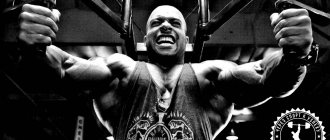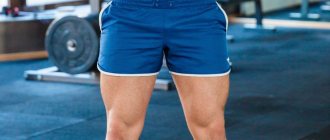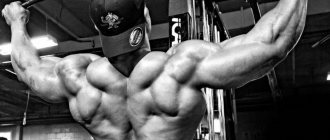Both beginners and experienced athletes are concerned about how to create the right training program. It is the consistent execution of a pre-compiled program that will allow you to achieve results. Unsystematic training, as a rule, ends in disappointment - there are no results, the motivation to exercise disappears.
Key points when creating a training program:
- training goal
- training frequency
- duration of training
- order of training different muscle groups
- choice of exercises
Training frequency
How often to train and how many times a week to train each muscle group?
All muscle groups can be divided into large (back, legs, chest) and small (biceps, shoulders, triceps, calves).
Large muscles take longer to recover after training than small ones, so they are trained less frequently, usually once a week (split training). However, beginners may not yet be able to train at the same intensity as more experienced athletes. They won't be able to work their muscles as well.
Therefore, beginners are recommended to work out all muscle groups during each training session, performing basic exercises, and go to the gym 3-4 times a week (example of a basic program). As your preparation increases, you can switch to split training - 3 times a week, each time you work out one large muscle group and 1-2 small ones.
All of the above is suitable for both those who are gaining muscle mass and those who want to lose weight. But to burn fat, you need to add either 1-2 more cardio workouts per week, or switch to high-repetition training - a large number of repetitions, short rest times between sets, light weights. You can also incorporate circuit training into your plan.
Examples of training schemes
Well-known experts have developed 4 basic schemes for effective training.
| Scheme | Description |
| Push-pull-legs program | The essence of this scheme is that the pulling groups are worked out on one day, the pushing groups on another, and the calf groups on the third. Typically, a training session will consist of more compound exercises, such as pull-ups, squats, deadlifts, and bench presses. |
| Working out antagonist muscles | Antagonists are muscle tissues that relax while other groups contract. The main advantage of such activities is the minimum amount of stress. |
| Working one muscle group in one training session | Working through one group in one training session. This type of circuit is most common among professional bodybuilders. To stimulate the growth of muscle fibers, the optimal training frequency is every 5-7 days. |
| Fullbody | Working through all groups in one training session. This is perhaps the most frowned upon scheme. |
Within each category, there are dozens of different variations and combinations of exercises designed to work specific soft tissues. The scheme should be developed on an individual basis, depending on the individual characteristics of the human body, his physical fitness, goals and the amount of time spent in the gym.
If you have difficulties in independently selecting suitable exercises, it is recommended to seek help from a professional.
Duration of training and rest between sets
On average, strength training lasts 45-90 minutes. The lower your fitness level, the longer each workout lasts. The heavier the weights and the fewer reps you do, the shorter the workout will be. Accordingly, strength training will be shorter than fat burning and endurance training. Read more in the article How long should a workout last?
Rest between sets is also directly related to your goals - for mass and strength gains, the rest is slightly longer (about 60 seconds, maximum 90) than for fat loss (45-60 seconds). Rest between exercises for about 90 seconds. Also, when performing isolation exercises (on machines) and exercises for small muscle groups, rest should be reduced by 15-30 seconds.
For gaining muscle mass
According to sports medicine recommendations, strength training should be performed at least twice a week. During this time, you will develop the main muscle groups: chest, back, shoulders, biceps, triceps, abs, anterior and posterior thigh muscles.
Remember that 48 hours of rest is necessary for any muscle recovery. Do not forget that to gain weight you need to pay attention to high-quality protein nutrition and appropriate caloric intake.
What to train with in the gym to gain weight? You should not load a large number of muscles at the same time, but the muscles involved should work to their maximum, if possible without affecting another large muscle group.
In this case, the body will specifically restore certain areas without wasting building material to bring the entire body back to normal.
Training opposing muscle groups is one of the most common types of strength training. At the same time, in one session they do exercises on antagonistic muscles, which ensure the movement of joints in opposite directions. Simply put, you work on the front and back of a specific area of the body on the same day.
Since you will need rest for the stressed muscles, it is convenient to train on a different part of the body the next day.
Advantages of this method:
- The target muscle group works to the maximum. You won't be able to achieve the same effect by training your whole body at once. By focusing on a different area each time, you will get results faster.
- Research shows that you engage muscle fibers more actively when you work or at least stretch antagonist muscles in the same session. This means that the chest press will be more effective after the mid-back stretch.
- Training antagonistic muscles ensures that you work both sides of the body evenly, maintaining a balanced development of the figure.
The disadvantages of this type of training include the fact that you will only work each muscle group once a week. Sample schedule for four workouts per week:
- Monday: chest and back.
- Tuesday: anterior and posterior thigh muscles, abs.
- Thursday: biceps, triceps and shoulders.
- Saturday: chest and back.
Next Monday, do thigh and abdominal exercises and continue the rotation further.
Another option for targeted muscle loading is to divide large muscle groups by day. Thus, one day you train the chest and triceps, the next day - the back and biceps, the next workout - the legs and shoulders.
The shoulders can be worked together with the pectoral muscles. This method of training is also convenient for a busy training plan.
Keep in mind that to improve performance and relieve stress on the nervous system, the training strategy must be periodically changed. For example, do exercises for the biceps together with the pectoral muscles, and the back with the triceps. This will diversify your workouts, relieve psychological fatigue and give impetus to further gain muscle mass.
The order of training different muscle groups and the selection of exercises
For beginners, it is recommended to work the entire body in each workout to improve overall fitness. Start with heavy basic exercises (Squats, Deadlifts, Presses), and end with isolation exercises (biceps, triceps, abs, etc. exercises). You can alternate workouts for the lower body (legs) and upper body (back and chest). At the very beginning, there is almost no point in pumping your arms with separate exercises - biceps, triceps, deltoids are perfectly worked out in basic exercises.
Try to do more exercises with barbells and dumbbells and a minimum of exercises. The exercise machines are intended primarily for those who, due to injuries or other health problems, cannot fully exercise with barbells and dumbbells. Trainers are also used by experienced bodybuilders when they need to work out lagging muscles in isolation. For beginners, exercises with free weights will give the best effect.
After 6-12 months, you can train in a split - each time attention is paid to one large muscle group and 1-2 small ones. There should be one rest day between training days to allow muscle recovery.
Which muscle groups are best trained together and in what order to create a proper split training program? For example, you train 3 times a week - Monday, Wednesday, Friday. On Monday, when you have the most energy, train the muscle group that is hardest for you to train, or the muscle group that is lagging behind. Most often these are the legs. Start with the base - squats, Romanian deadlifts, lunges. Afterwards, you can do leg flexion/extension exercises on the machine.
At the end, do abdominal exercises if you have any strength left. On the day of chest training, first you perform barbell and dumbbell presses at different angles, push-ups from the floor/on parallel bars, and dumbbell flyes. After triceps and deltoids exercises. On the day of back training, first do deadlifts, barbell rows, and pull-ups. You can alternate between dumbbell rows and block rows. At the end, add biceps exercises.
Which muscles can be trained in one day, and which ones cannot. Which muscles should you train together?
Combination of muscle groups during training.
The essence of the Split system, which is dominant in bodybuilding today, is that in one workout you can load 2 or 3 muscles. But in what combination? Many experts believe that one large muscle group with a small muscle assisting it is best combined in one workout. For example, triceps and chest. Moreover, the load should mainly be placed on a large muscle group
. If you start training with an assisting muscle, its fatigue will negatively affect the performance of the main muscle group. It is also not advisable to train the back and chest muscles at the same time as two large muscle groups.
Where is the truth? Numerous experiments with the participation of security forces have revealed that it turns out that the back and chest can be trained together, only the chest should be loaded first. As for the biceps and triceps, regardless of the order of training, they do not show a loss of strength. But the deltoids behave like the chest muscles. That is, it turns out that deltoids and chest cannot be combined.
The order of working out muscle groups. The greatest amount of anabolic hormones are released during exercise with moderate weight, multiple sets of 10-12 repetitions, and a rest period of 1.5 minutes. We are talking about hormones such as testosterone, growth hormone and growth factor 1, similar to insulin. So, when training large muscle groups, a more significant synthesis of hormones occurs than when training, such as triceps or biceps, that is, small ones. What happens if you work on both at the same time? Will the effect of the former spread to the latter? It turns out that this is exactly what happens. This has been confirmed by numerous studies. For example, two groups of previously untrained men performed exercises: the first worked with biceps, the second - after training their legs with the same biceps. So, in the second group, a much greater release of anabolic hormones was detected. Another well-known contralateral effect is that when training one side of the body, the second, symmetrical to it, is also stimulated. That is, by training one arm you can slightly increase the mass and strength of the second. The reason is the stimulation of nerves that stimulate both sides of the body. Popular among bodybuilders is the “Pull-Press” principle, in which on one day you train the triceps after the back, and on the other, the biceps after the chest. In any case, the largest muscle groups should be trained first. There are two reasons: They require large amounts of energy; By loading them, we provide maximum anabolic steroids. We break down the main muscle groups by day: 1 - chest;. 2 - legs;. 3 - back. Then we supplement their training with secondary muscles. 1 day. We perform basic chest exercises, while also using a secondary muscle - the triceps. Therefore, after loading the chest, we finish off the triceps. The secondary muscle gets excellent workload and time to recover, because on other days neither the chest nor the triceps will be used and will undergo a full recovery, which is very important when gaining muscle mass. Day 2. Legs and then shoulders. Day 3. Back and biceps. The biceps as a flexor helps already in the first back exercise. After the back, we perform biceps training.
Another distribution scheme: Workout 1: pumping the legs, additionally loading the back columns and lower back. Only if you still have strength, load your biceps. Workout 2. load on the chest, triceps, anterior deltoids, abs. When pumping the chest, the triceps will be involved along with the front deltoids. Having pumped up the front deltoids, you just need to finish off the triceps. Press at the end. Workout 3: full back. It is impossible to pump up the upper back without involving the biceps. Workout 4: Shoulders engage triceps. Don't forget about your abs, neck and trapezius.
Split example. Monday: chest, shoulders, triceps brachii; Wednesday - back, biceps brachii, forearm; Friday - thighs, buttocks, calf muscles. We pump up the press every workout: On Mondays - top;. On Wednesdays - obliques; On Fridays - lower abs.
Conclusion. There is simply no single system. Much depends on the characteristics of each individual, and how long it takes to recover. There are two reasons for a competent combination of muscle groups, 3-4 days to implement such training, and there is only one condition - visiting the training room at least 2-3 times a week, which will guarantee effective and competent training of all muscle groups.
For newbies
Before you start training, determine what your goals are - to tone your body, develop strength or endurance, lose weight or gain mass.
It also matters how many days a week you can devote to training. If you only train twice a week, a full-body workout may be the best option, targeting all muscle groups and preparing them for more advanced training options.
For beginners and after a long break, it is recommended to start training with basic exercises with moderate weights. At the same time, do not forget about the warm-up and cool-down each time.
Work the large muscle groups first: legs, chest and back. For example, deadlifts and bent-over rows work multiple muscle groups at once. Then move on to working small groups: triceps, biceps and shoulders. Do 2 exercises per group per workout to avoid overtraining.
As you develop strength and endurance, you can diversify and intensify your training (add exercises or increase weights).
Beginners often believe that if they work out their abs every day, it will quickly get rid of belly fat and create those coveted abs. In fact, the abdominal muscles work on the same principle as any other muscle group. Therefore, it makes sense to give them at least a day of rest between training days. Working out the abdominal muscles is often combined with exercises for the back or legs.
To increase strength
To increase strength indicators, you should pay maximum attention to the basic exercises of powerlifting: deadlift, bench press and squats with a barbell.
In this case, it is necessary to do a large number of approaches (from maximum weights, but a small number of repetitions in one approach. Each of the workouts includes all 3 exercises from powerlifting, but on the day of working the pectoral muscles, a light training session is performed on the back and legs.
maximum weights, but a small number of repetitions in one approach. Each of the workouts includes all 3 exercises from powerlifting, but on the day of working the pectoral muscles, a light training session is performed on the back and legs.
To increase explosive strength, use superset training, a method in which you do exercises for each muscle group one after the other without resting in between. Supersets can be very challenging and are not recommended for beginners. In a short period of time, such training will help you squeeze out maximum benefits for your body.
What to download with what in one day in this case? Example of a 3-day workout:
- Monday: bench press, bench raises, barbell squats, squat press.
- Wednesday: lat pulldown, lat pulldown, deadlift, hip extension.
- Friday: lifting dumbbells forward and abducting arms to the sides, plank, crunches.
Such deep study of muscle fibers from different angles provides an advantage for the uniform development of muscle structure. Supersets stimulate the production of lactic acid, which increases the content of growth hormone in the body. This hormone activates fat burning and muscle growth.
In addition, such training increases your heart rate, gives a boost to your metabolism, and you burn more calories throughout the day.
How often should you go to training?
From the very beginning, any athlete asks this question, but to choose the optimal number of training sessions per week, several factors need to be taken into account:
1. Which muscle groups will be involved.
All muscle groups can be divided into two categories:
- small (calves, deltoids, triceps, biceps);
- large (chest, back, legs).
Remember that if the training was on large muscles, then they will need a day more break for recovery than a group of small muscles.
2. Current level of preparation. If you have been training for a long time, then the body is adapted to the stress and the muscles are restored in a shorter period of time. Also, smaller muscles recover faster.
3. Training volume. It is definitely worth taking into account. If the training was long and hard, then the body received a colossal load. This means it will take a long time to fully recover. Don't forget about supercompensation and learn to determine when your body is ready for stress again.
Of course, each coach has his own view on the required intervals between workouts. But most are inclined to believe that a beginner can visit the gym often at first, but with light loads. This solution allows you to gradually adapt to the loads and increase the efficiency of training. Another aspect of this solution is that a beginner’s muscles are not yet very voluminous, which means they recover faster than the voluminous fibers of a professional.
When creating a program, keep in mind that on average, for beginner athletes, each muscle group is completely restored in 2-4 days.
In one of the articles on our website, we talked in more detail about how often you should go to the gym. Statistics, differences for beginners and experienced athletes, as well as features of post-gym training during strength and fat-burning training.
For weight loss
If your goal is to lose weight, training should take maximum energy and burn calories effectively.
What to train with what in one day for weight loss? Functional training is well suited, in which almost all muscle groups are worked out in one session.
Choose circuit training or CrossFit to start the fat burning process and create a toned figure. Use cardio exercises as a warm-up and cool-down. Do not forget about the caloric content of your diet: the intake of calories should not outstrip their expenditure by the body.
In weight loss training, basic multi-joint exercises are performed; they involve the work of both the upper and lower body. For example, instead of regular lunges, you perform a lunge with a barbell overhead press.
Core exercises encourage the body to work more efficiently, increase your heart rate and boost your metabolism, causing you to burn more calories. Examples of exercises you can include in a full body workout:
- bench press for pectoral muscles;
- block pull for the back muscles;
- dumbbell shoulder press;
- squats;
- biceps curl;
- French press for working triceps;
- Ab crunches;
- standing calf raise for calf muscles.
Thanks to this technique, you will work the muscles of the whole body several times a week. It is optimal to train 3 times with a rest day between training days.
This type of physical activity is also suitable for beginners, since it limits the number of sets performed per muscle group and better prepares the body for subsequent loads and weight gain.










